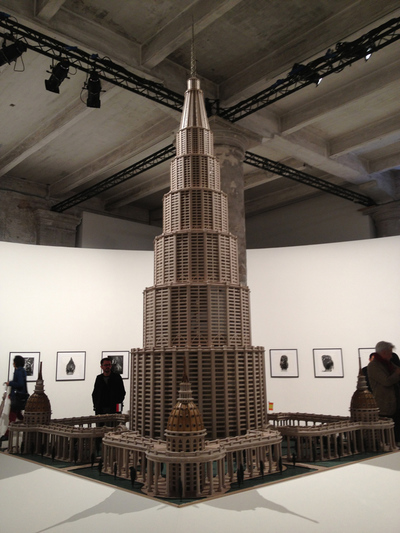The 55th International Art Exhibition of The Venice Biennale Opens
Fran Siegel
I attended the 2013 Venice Biennale preview during May’s last 3 days which did not resemble the shimmering glam of yesteryear. Instead, clusters of make-shift raincoats and umbrellas soggy shoes, and layered mismatched outfits meandered through town hoping to stay warm and dry amidst the downpours. Despite only two years to prepare and the high curatorial bar set by dOCUMENTA 13 in Kassel last year, Artistic Director Massimiliano Gioni chose the ambitious title “Encyclopedic Palace” based on his pseudo-surrogate Marino Auriti, (also an Italian American) who filed a patent in 1955 for an imaginary museum that could “house all world knowledge.” Gioni used the framework of this “temporary museum” to speak about the channeling of images in an information age, artistic obsessions, surreal dreams and hallucinations, and ultimately the transformative power of the imagination. Unfortunately as the manic organization of several artists’ “cabinets of curiosities” felt too similar, by the end each became somewhat silenced. Many discussions ensued amongst colleagues that critiqued the way “outsider” or “otherness” was displayed as exotic, the repetitive ghoulishness of many of the distorted figurative sculptures and paintings in the Arsenale, and whether a revision of 90’s identity politics is relevant now. Provoking dialogue is important, and there were many remarkable aspects of this massive exhibition, not least of which was the emphasis of drawing as a direct extension of of human consciousness. Gioni should also be commended for going outside the predigested list of Gagosian vetted and sponsored artists especially in the time of corporate muscle.

In line in the rain at the Arsenale

Model of “Encyclopedic Palace” Marino Auriti
The Biennale Layout:
1. The Giardini where countries are represented by their own pavilion.
2. The Arsenale where much of the group exhibition is. The Arsenale also houses an increasing number of individual country pavilions such as Lebanon, Chile, Turkey, Georgia, and China. And the Giardini contains the Central Pavillion which contains a major part of the “Encyclopedic Palace.” I strongly suggest to begin here with Carl Jung’s red book of 1913 as the show reads curatorially tighter in the smaller scaled spaces. At the Arsenale this pace opens up. The otherwise rambling arena has been redesigned by architect Annabelle Selldorf, which makes the space more formal but so many circular viewing positions became heavy handed.
3. The Biennale hosts multiple collateral events in palazzos, churches and alternative spaces. These include projects by Ai Weiwei, Terry Smith, Shirazeh Houshiary, and Lawrence Weiner. For more information check: http://www.labiennale.org/en/art/exhibition/collateral-events/
4. Several Museums have notable solo exhibitions including Antoni Tapies at Palazzo Fortuny, Anthony Caro at Museo Correr, Robert Motherwell at The Guggenheim, Jacob Hashimoto and Qiu Zhijie at Fondazione Querini Stampalia, Rudolf Stingel at Palazzo Grassi, and Edouard Manet at Palazzo Ducale.

A wonderful accumulative drawing by Uri Aran in the Arsenale

Massimiliano Gioni at press conference
To be continued… next up: How five artists altered the architecture of their country’s pavilion to subversively initiate political dialogue.
The 55th International Art Exhibition in the Arsenale and Giardini runs from 1 June to 24 November 2013.
Fran Siegel is an artist living and working in Los Angeles.
